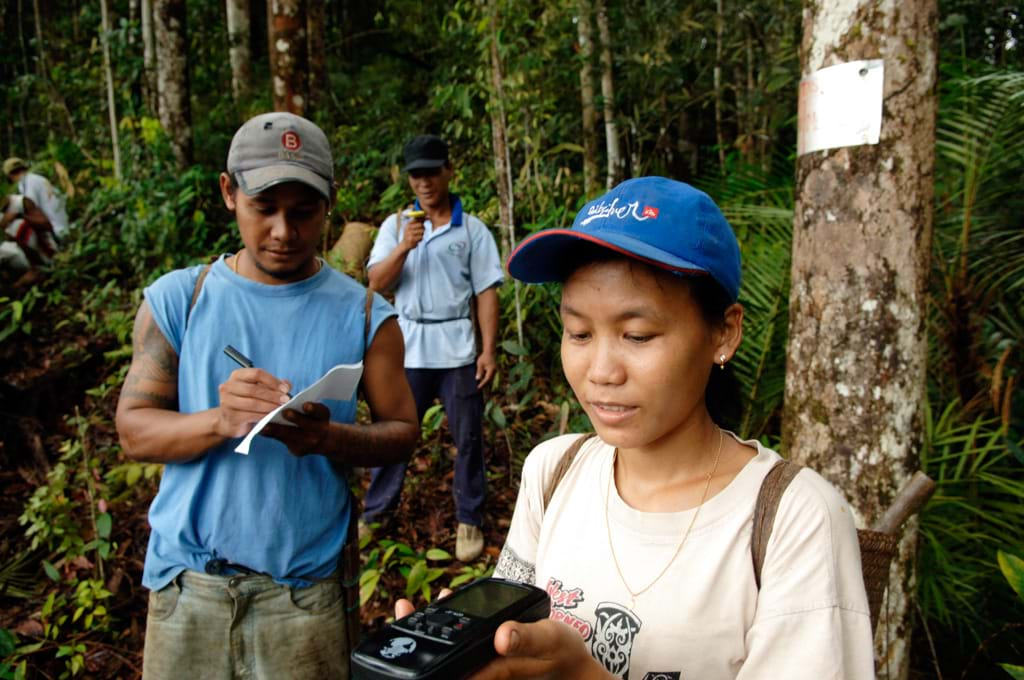
On Sunday, April 13, Showtime will premier The Years of Living Dangerously, a new documentary series supported by the foundation that explores the human impact of climate change. In anticipation, we spoke with Steve Rhee, who works on community rights over natural resources and climate change from our office in Jakarta, about the critical connection between these issues.
First, some important background: Indonesia’s government has claimed 60 percent of the country’s land as “state forest zone,” placing it under the authority of the Ministry of Forestry and legally erasing the rights of some 60 million indigenous people and other communities who have long called those lands home. With this zoning in place, government agencies permit companies to clear natural forests and establish industrial plantations that destroy the natural environment and threaten, or altogether displace, the communities that have been managing the land sustainably.
Together with our partners, we are working to secure recognition of these communities’ rights so they can continue to manage their forests sustainably and participate and prosper as full citizens of Indonesia. Sustainable management of these lands and resources is critical to mitigating climate change, the dire environmental impacts of which these communities know all too well.
In the first episode of the Showtime series, Harrison Ford travels to Indonesia to investigate how the world’s appetite for palm oil has led to massive deforestation and turned the country into one of the world’s largest emitters of greenhouse gases. Here, Steve Rhee talks about some of the communities that are most deeply affected, and the most promising ways forward.
Accessibility Statement
- All videos produced by the Ford Foundation since 2020 include captions and downloadable transcripts. For videos where visuals require additional understanding, we offer audio-described versions.
- We are continuing to make videos produced prior to 2020 accessible.
- Videos from third-party sources (those not produced by the Ford Foundation) may not have captions, accessible transcripts, or audio descriptions.
- To improve accessibility beyond our site, we’ve created a free video accessibility WordPress plug-in.
Climate change is increasingly well understood, though we have a long way to go. But even people who have a good understanding of it may not quite get how deforestation figures in. Can you explain the connection?
The cause of climate change is greenhouse gas emissions, primarily CO2 going up into the atmosphere. Globally, a fifth of carbon emissions come from the conversion of forests and peat lands for development or other uses. In tropical forests, massive old-growth trees store a lot of carbon, and when you chop those down, you release stored carbon into the atmosphere. What we call peat lands here in Indonesia are a kind of swamp made up of what are essentially dense mats of layer upon layer of carbon. When those swamps get drained, all that carbon gets released into the atmosphere.
Here, these forests and peat lands are primarily converted for oil palm and industrial timber plantations. The products that come from them—palm oil and wood pulp—aren’t bad in and of themselves. But the way the plantations are established and the way business has traditionally been done is through relentless expansion, taking up more and more land, and that’s become a real problem.
Millions of people live in those forestlands and peat lands. In the eyes of the government, they have almost no rights to be there, even though many of them have lived there for generations and those areas are their ancestral domains.
What’s life like for these communities?
It’s very difficult, because their claim to the land and the natural resources they depend on is so insecure. There’s always a low hum of anxiety and worry that becomes a high level of stress and panic when a company comes in with bulldozers and other heavy equipment to clear a community’s forests and take over their land. And when villagers protest, the company tells them they have a permit from the government, while the communities lack this legal recognition.
Imagine living in a swamp: If you have to eke out a living in a place like that, you’re already in a difficult place. I visited a village in Sumatra that was being squeezed by an oil palm plantation on one side, and by a timber plantation on the other side. On yet another side they had been essentially backed up to the ocean. So it’s a very distressing life for a lot of these communities.
For people here, climate change is a part of life. We see it with more frequent and extreme weather events, and worsening floods in places like Jakarta—a place that’s already notorious for floods. It’s a huge cost to the economy and a huge cost to the people who can least afford to deal with floods. Rural communities feel it every day through harvest failures, and they’re the most vulnerable in terms of other impacts.
The UN report that was issued at the end of last month emphasized that climate change will worsen problems that we already have, including poverty and violence, and further degrade economic growth and crop production. How are you seeing that play out?
Indonesia is in a very difficult situation. Because of its conversion of forest and peat lands, it is the third largest contributor to global greenhouse gas emissions after China and the U.S. But the country is also feeling the impacts of climate change quite dramatically, and is high on the list of vulnerable countries. It’s an archipelago, with a lot of islands, and geographically it’s already prone to a lot of dramatic weather events. The more extreme events related to climate change—like we’re increasingly seeing in the U.S.—are also getting worse in Indonesia. And the people who are being hit the hardest are those vulnerable, rural and forest-dependent communities.
How are you working to address these challenges?
We are funding a number of initiatives to literally put indigenous communities and other rural communities that depend on forests on the map. So we support a lot of participatory mapping efforts of claims over land, forests and other natural resources, along with efforts to get those maps recognized by the government and the private sector.
At the end of the day, the decisions companies make in Indonesia are dictated in large part by consumer behavior in places like the U.S. and Europe. Consumers have a lot of power to vote with their wallets. So we’re also working with organizations that are engaged in the whole supply chain from soup-to-nuts—from the fields, plantations and villages all the way to the corner shops, supermarkets, and big box stores—to get everyone involved to commit to conflict-free, deforestation-free products that were produced with a mindfulness of human rights. We are seeing the power of consumers telling companies they want these kinds of products in the recent corporate sustainability commitments from Unilever, P&G, Disney, Nestle and Kellogg’s, just to name a few. These companies work with their suppliers, many of whom are in Indonesia, to implement these social and environmental standards.
In terms of working with the government, we support Indonesia’s amazingly progressive, unilateral commitments to reduce emissions by 26 percent by 2020. The president has said that with international help, the country can achieve a 41 percent reduction of emissions by that year. We work closely with government to help realize Indonesia’s commitment to sustainable growth with equity.
What kind of progress are you seeing, and how hopeful do you feel about the direction this is all heading?
Indonesia has made amazing, almost unparalleled progress as a country: Essentially, it has grown from an authoritarian regime to a vibrant democracy in 16 years. And we’re seeing the growth of a vibrant civil society as well. In a very short amount of time, we’ve also seen significant progress in terms of recognizing the claims of forest-dependent indigenous communities. Government and the private sector understand that marginalizing these communities is not good for business and not good for growth.
Indonesia can continue to grow its GDP without converting its forest and peat lands, releasing carbon emissions and marginalizing its own citizens. In this country and elsewhere, evidence shows that indigenous and other forest-dependent communities manage forests well. They’re better stewards of the forest than the government.
And so if we as a global community are serious about dealing with climate change, we need to support efforts for indigenous and other forest-dependent communities to have legal rights and recognition to manage and own the forests that they’ve been managing sustainably for some time. The more we support their rights to manage their lands, the more progress we make in fighting climate change on a global scale.
